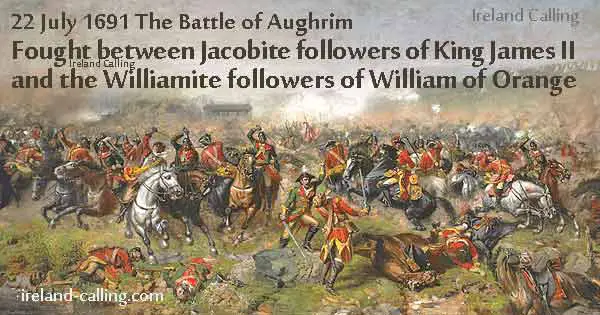july-top.html
1691 The Battle of Aughrim took place on this day in 1691. It was fought between the Jacobite followers of King James II and the Williamite followers of William of Orange.
William had dethroned James and taken control of Ireland, as well as England and Scotland. The battle was part of the Jacobite Wars in Ireland, part of the larger Nine Years War across Europe.
The Battle of Aughrim took place in Co Galway. In the previous year, the Jacobites had been forced to retreat across Ireland towards Connacht.
They still held the towns of Sligo, Athlone and Limerick and were hoping to use the River Shannon as a defensive barrier until they could receive military reinforcements from Louis XIV of France.

Around 20,000 Williamite soldiers moved forward and after taking the town of Athlone they pressed on. They encountered the Jacobite forces at Aughrim. The Jacobites had the superior position at the top of a large hill and were able to take the early advantage with the first waves of Williamites being helpless against the fire from the high ground.
The Williamites continued to surge forward but split their attack into three assaults to make it more difficult to defend. Two of the three assaults were disastrous, with the Jacobites forcing them to retreat into the surrounding bogs where hundreds of soldiers drowned. The third Williamite assault successfully moved forward only to find the Jacobites had moved their position and retreated.

* * *
1817 Windham William Sadler became the first man to successfully fly a hot air balloon across the Irish Sea on this day in 1817. His father had always been passionate about aviation, and had flown hot air balloons both successfully and otherwise throughout his life.
Sadler was infected by his father’s enthusiasm for hot air balloons, and continued to strive for his dream of crossing the Irish Sea. He successfully completed the feat when he set off from Dublin and safely landed at Anglesey. The journey took a little more than five hours.

During the middle of the flight, Sadler wrote:
“I enjoyed at a glance the opposite shores of Ireland and Wales, and the entire circumference of Man.”
* * *
1866 David James O’Donoghue was born in Chelsea on this day in 1866. He was a writer and journalist and wrote extensively about Irish music and literature. O’Donoghue was one of the founding members of the Irish Literary Society in Dublin, and also held the position as vice president of the National Literary Society in Dublin.
He had several books published about Irish art, poetry, language and culture. O’Donoghue also wrote about several past Irish characters. He compiled a selection of poetry by Samuel Lover and wrote biographies of leading political figures including Robert Emmet.
Click here to read about some of the greatest Irish writers
* * *
1873 James Cousins was born in Belfast on this day in 1873. He was a writer and actor who was part of the talented literary circle in Ireland in the early 20th century, along with the likes of WB Yeats and James Joyce.
Cousins wrote several collections of poetry, and also acted opposite the beautiful actress and Irish nationalist Maud Gonne.
Cousins and Yeats fell out when Yeats questioned the number of Cousins’ plays that were being sanctioned by Dublin theatres. The split between two of the most influential writers of the time caused a mass split in actors and theatre managers in Dublin, with about two thirds choosing to side with Cousins.

Cousins later moved to India with his wife and grew fond of the Hindu religion and value system. He settled and became friends with various members of India’s elite literary and acting community.
* * *
1922 John Benignus Lyons was born in Co Mayo on this day in 1922. He was a leading Irish medical practitioner throughout his life, once described as “one of the foremost Irish medical writers of the twentieth century”.
Lyons studied medicine at University College Dublin and went on to work in various hospitals in the city. He became a member of the Royal College of Physicians of Ireland. After spending time as the onboard medic on a cargo liner sailing around Japan and South America, Lyons settled in Manchester, England and married.
He and his wife had three children before returning to Dublin where Lyons held senior roles at various hospitals.
Lyons wrote his first book in 1974, called A Primer of Neurology. More medical history books followed, and then biographies of various Irish figures including Tom Kettle, the Irish soldier who died in the First World War, made famous by his moving poem written in the trenches;
‘To My Darling Daughter Betty’. See poem here
Lyons’ work was well received by the public and he started to write fictional books, many of them set in hospitals.
* * *
2007 Pádraig Harrington won the Open golf championship on this day in 2007. The Dublin star made up six shots on Sergio Garcia during a thrilling final round at Carnoustie Golf Links in Scotland to tie the tournament lead at seven under. The two men went into a tense playoff which Harrington eventually won after four holes.
The victory secured Harrington’s place in Irish sporting folklore forever. He became the first ever person from the Republic of Ireland to win a golfing major, and the first from the island for sixty years.
Another thing of note about the tournament was that it was the first major played by then-18-year-old Rory McIlroy. He shot a five over par for the tournament to win the silver medal for best amateur.
Read about more top Irish sports stars
july-bottom.html